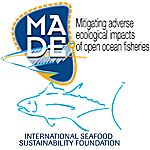In the Philippines small-scale purse seine nets are used near anchored fish aggregating devices (FADs) (payao) to capture small pelagic fish. These gears sometimes capture juveniles of tuna together with small pelagic species that also associate with the payao. To evaluate the sizes of small pelagic fish relative to tuna juveniles that are captured by small-scale purse seines, a mesh selection experiment was conducted using a typical gear by replacing its bunt with an experimental bunt bearing 21 pocket nets that open to 1.5 m x 1.5 m square net panels. All net panels had the same hanging ratio and twine diameter but had 11 different mesh sizes. These panels were randomly arranged horizontally and vertically into a T-shaped section that was cut out from the experimental bunt. Over 30 species including round scad, bigeye scad, sardines, and tuna species like yellowfin, bullet and frigate tuna formed part of the catch; the most abundant species were roundscad and bigeye scad. The selectivity curves of roundscad, which has a circular cross section, were sharper than bigeye scad, which has a slightly elliptical cross-section. Based on the recommended mesh size of 15.2 cm for tuna seiners in the West and Central Pacific Ocean, 50% of bigeye scad and only 10% of the captured roundscads were retained. This result indicates that mesh selection is difficult even among fish with slightly similar body forms and highlights current challenges in pelagic fisheries management in Philippine waters where matured small pelagic species mix with tuna juveniles .
- Presentation

 PDF version
PDF version
